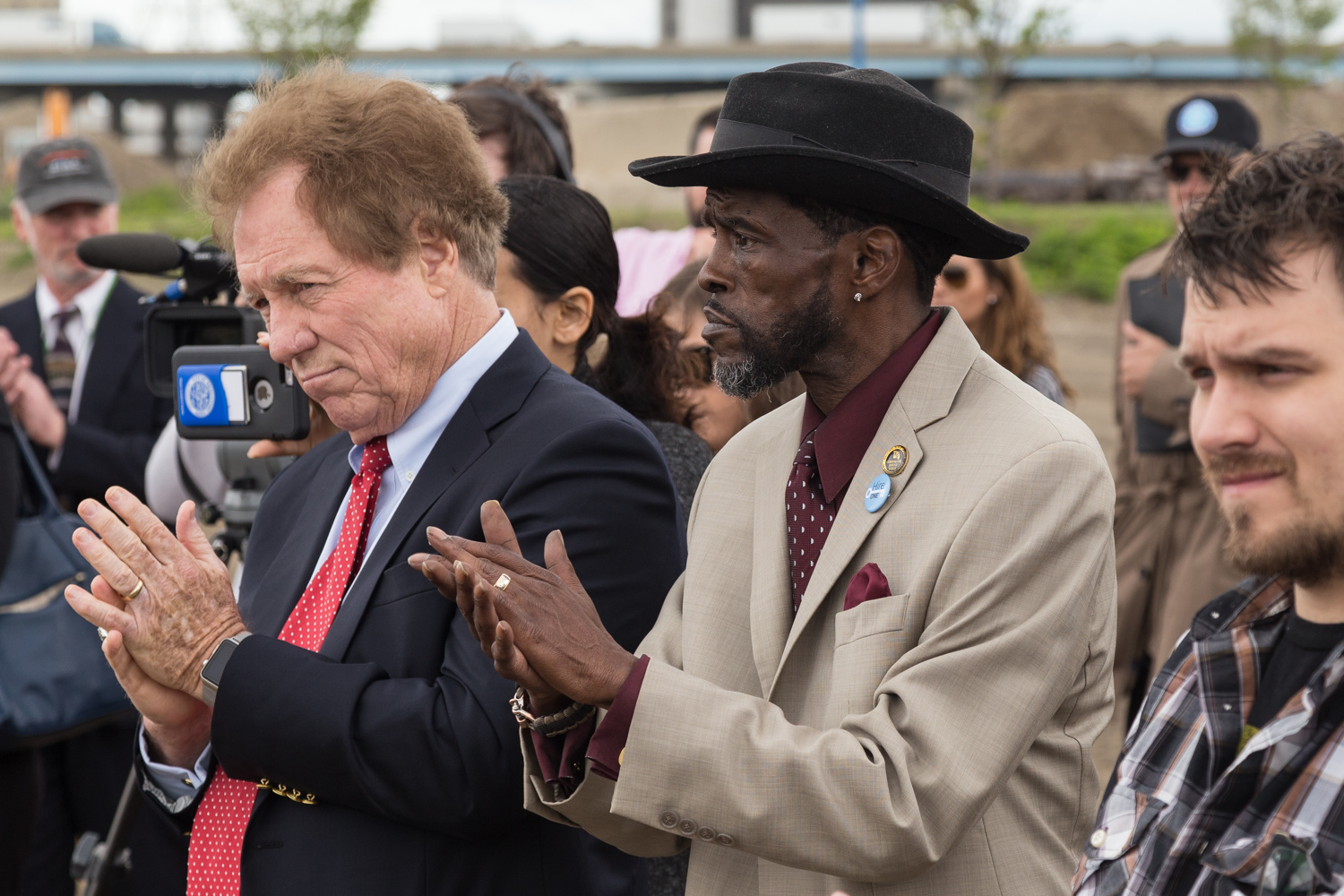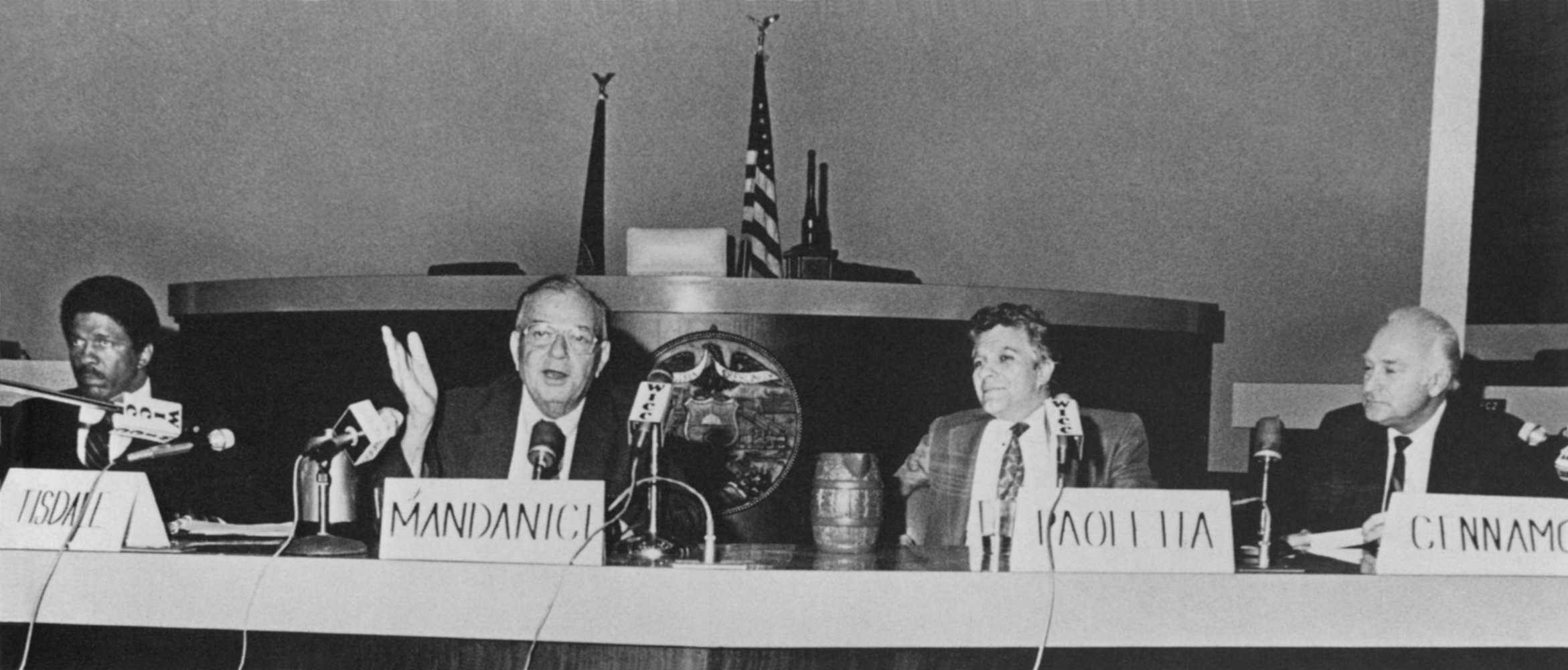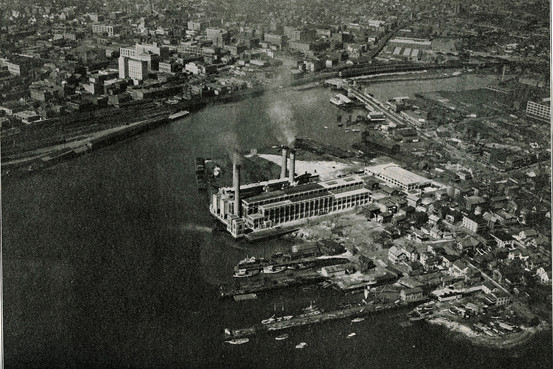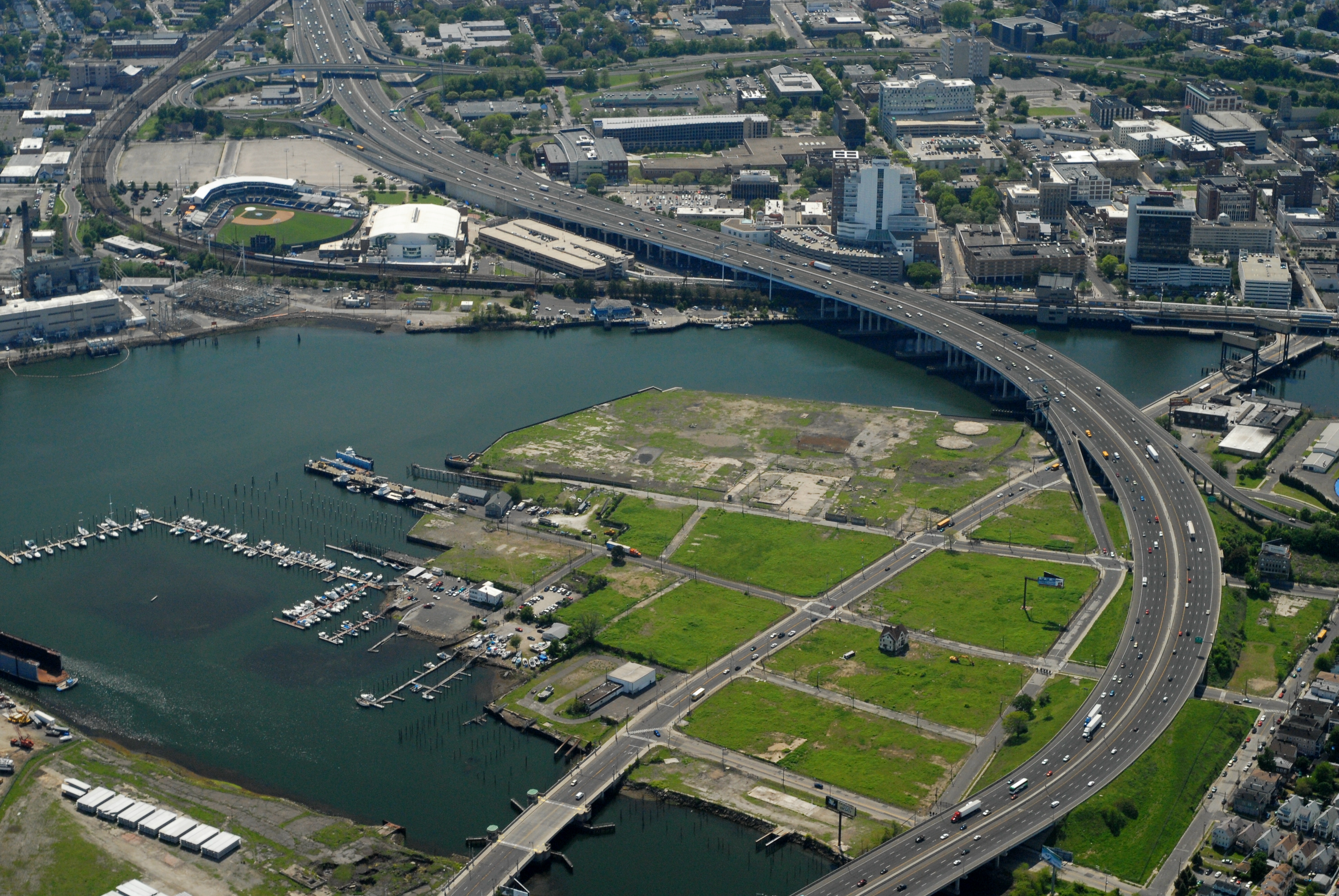
City Councilman Ernie Newton recalls the Steelpointe Harbor redevelopment area that once flashed a neighborhood warzone cut off from the harbor, a hulking vacant power plant a reminder of an industrial age in decline.
The area is a spit from Downtown where the East Side and East End merge along the waterfront.
In August 1983, Mayor Lenny Paoletta announced an ambitious plan with two notable Bridgeport developers Irwin Stillman and Fred Frassinelli to resurrect the landscape featuring housing, hotel, retail, marina and public walkway. By Bridgeport terms it was a massive urban renewal project that required market rate acquisition of parcels via eminent domain, a process that did not begin in earnest until more than a decade later.

How to save the city from economic doldrums? Paoletta’s election year announcement was splashy and detailed, a 20-year $700 million investment. The developers called it Harborpointe, Stillman noting the e at the end as an affectation.
Paoletta was a mayor allergic to process. If he could find a way to do it, he’d have bulldozed much of the neighborhood damn the consequences. Newton was a young City Council president from the East End, the first minority to occupy the position, who viewed neighborhood decline before his very eyes, Bridgeport’s gleaming industrial age and tax base falling to pieces. One by one by one the captains of industry pulled out for cheaper southern and offshore wages, movement to the midwest closer to the auto industry, Bridgeport arms and munitions factories reliant on wartime economy folding up. Bridgeport Brass gone, Remington arrivederci, Singer Sewing sayonara. And many more.
Bridgeport was still very much a white community then with an eclectic mix of black, white, brown occupying this portion of the city, but changing by the year as white flight continued to mount.



Financing, condemnation and cleansing a filthy site takes time. By 1985 Paoletta was out as mayor and the next two mayors Tom Bucci and Mary Moran lasted only four and two years as mayors respectively. Government stability is key to shepherding this type of project. Paging Baltimore.
The city a young Joe Ganim inherited in 1991 was literally in bankruptcy court placed there by his predecessor for which he required a local expert to help him Contesting A Will No Win No Fee and avoid some of the debt inherited. The city had been a messy stew of tax increases, increased crime and industrial flight.
Stability came under Ganim with significant help from then-Governor Lowell Weicker. In the mid/late 1990s eminent domain began a plodding process to clear the site for remediation: many residents, paid market rates for property, couldn’t wait to get out, others persisted, it’s never easy dealing with a church, small marina and properties considered of historic value.
A new development team came along in 2001, led by Robert Christoph Jr and his father. The John Fabrizi and Bill Finch mayoral years both moved the needle for the site to become development ready.

Fast forward to 2021: if you knew what was there in 1983 and escorted to the site blindfolded about two generations later you’d think nirvana swept you away.
Government and private investment as well as developers with a history of waterfront achievement have transformed now Steelpointe Harbor into an urban renewal success: Bass Pro Shops, 220-slip marina, public boardwalk, Boca Oyster Bar, a shipyard revitalizing vessels navigating New York Harbor, hundreds of jobs for Bridgeport people all real.
Monday night a public hearing took place on what is now considered the lynchpin for the project’s buildout: 400 units of market rate housing, hotel and other amenities, a projected $100 million investment scheduled to break ground in the spring. The Christophs seek a 10-year tax break. Two million dollars in building fees are due at the start of construction along East Main Street and Stratford Avenue.
Under the terms of the agreement, the developer will pay taxes on the cost of the land for three years annually, $23,900, during the construction and occupancy phase. Tax payments will increase to $1.26 million in 2025, rising by two percent each year, reaching $1.47 million in the final year of the abatement. Full standard taxation will then commence. Even with a tax break that’s a significant amount of dough into the city treasury that otherwise will not be realized.
During the virtual public hearing, a steady stream of development supporters including elected officials, neighborhood residents, business community, nonprofits, urged the City Council to approve the tax abatement, citing the jobs, economic impact and new investors coming into the city, as well as the goodwill built by the Christophs in the areas of affordable housing, Stratford Avenue development and community charity. They have invested tens of millions of their own money.
A few called in to oppose or support it conditionally. For instance representatives of the community action group Bridgeport Generation Now want a set-aside for 20 percent of the units classified as affordable housing, claiming it would otherwise be systemic racism. City Councilwoman Maria Pereira just outright opposes tax breaks, arguing working and middle class bear the burden of such deals.
This notion that tax breaks cost taxpayers money is a complete fallacy, a point argued by Newton Don’t complain about the mil rate being high and then condemn developers for wanting the economics to work. If the tax deal isn’t approved you’re left with zero.

Mired in narcissistic myopia, did it ever occur to Pereira to examine what was then at the site and what is now?
She pressed the misplaced point about tax burden on her constituency.
Newton fired back “Some don’t pay taxes,” a shot at the jobless Pereira who doesn’t pay city taxes but benefits from city services such as police, fire, public works, parks and libraries. There are taxpayers and there are tax takers.
Newton took the lead last night parrying arguments black and brown people cannot afford market rate housing, a point also echoed by State Rep. Antonio Felipe who resides in market rate housing Downtown.
“Don’t make black and brown people orphans,” Newton declared, adding the city needs market rate housing from investors who’ll spend money in the city
For those who want to press affordable housing set aside, he argued, take the claim to the suburbs.
The morning after the public hearing Newton reiterated his support for the project and what it means for the community as a whole.
“Look what they’ve done for the waterfront. No one else has done that.”


Ernie, GENTRIFICATION, look it up and tell me the difference between with this plan? Seeig that portions of this plan is in your district the players involve will do anything to get this project approve but what about those who will be displace?
Kudo’s to Ernie Newtown and all individuals supporting this project that has been a dream since 1984. At this point I’d like to see this project pick up the pace. 150,000 plus cars pace through Bridgeport daily. This will be the best Marketing the city can do for itself. I’d like to see Market rate housing on that side as well as AGI and the old Jai Alai. We need individuals that can create new neighborhoods and support existing and new business. This is the future as well as Remington Woods. For 30 years we have been waiting for a clean up and development of those 420 plus acres. I think the compromise was fair. We are the largest city in the state. The poorest city in the State. Without Major development, what hope is there to lower our taxes. The is Bridgeport’s time. All development has been bypassing the city. Ansonia, Milford and Derby are looking to build 12 story Buildings while we continue with 4 story buildings- Park Avenue should be dotted with luxury High rises. Public Storage Facilities are not development. Steelpointe and Remington Woods are the last opportunity for major well thought out development . Many contiguous acreage can only be found in the nearly 900 thousand square feet of obsolete manufacturing standing on contaminated brownfields.
I commend Ernie Newton and all of those elected officials that have supported these projects. Regarding Property values and affordable housing, Keep in mind that there are thousands of Black/Brown/ White and Asian families that live in the Eastside that have waited decades for their investment to increase. Gentrification is not a dirty word when it gives a breath of new life to a neighborhood. Harlem would be a perfect example. You can not recreate those magnificent Brownstones and in Bridgeport, the East side and East end are home to the largest housing stock of Victorian Homes in the State. We have some much to be proud of. Right now., It is the East End’s Time to shine. Shout out to Eneida Martinez who has been a partner of Newton and supportive of this project coming to fruition and it is my hope that Councilwoman Wanda Simmons continues to be a good partner in bringing fruit to the East End. We are all in this together. As every corner of this city goes, we all go!!
Just because he remembers the decline doesn’t mean he’s responsible for the improvements.
Ernie Newton taking credit for Steelpointe is like the weatherman taking credit for a sunny day.
The Steelpointe agreement gives the developers certainty, durability and visibility — the three best attributes of any business proposal.
Unmentioned is the fantastic, underground warehousing operation that the developers have kept for themselves.
If they’ve invested millions of their own money, why do they need/deserve a 10-year tax break?
If the tax deal evaporates, Bridgeport isn’t in bad shape (ask Ernie) — the developers are.
Call their bluff and watch Bridgeport’s prospects rise — the world is full of developers who would love to fill the void created by the CC’s boldness!
Supporters of the tax deal play the politics of appeasement and praise the status quo.
Those who oppose it understand taxpayers would be backstopping a $48M revenue bond (wealthy strangers) and taking the risk out of the developer’s investment. The CC has unused bargaining power and with bold leadership could improve Bridgeport’s position.
Bridgeport needs an aura to replace its stigma.
The closing down of Harlem restaurants because they couldn’t afford the rents which increased exponentially, is a product of the influx of wealthy younger, non-natives into Harlem, forcing soul foods’ traditional customers to leave the neighborhood.
71 Black owned businesses and their 975 workers were displaced in the first 10 years. Stripping 125th street of its identity by turning it into another Manhattan high street might be a success commercially, but culturally a disaster.
Harlem, the historic capital of African American culture, the process of progress appears to be stomping out a long history of rich black culture and community, placing its current residents in positions of home insecurity. 32,500 Black Harlem residents moved out of the area, while 22,800 white residents moved into it, between 2000 and 2005.
There is an ugly side of gentrification that have never hurt white people, yet they always take the side of gentrification while extolling the financial gains for this act which never benefits the Black and Latinx residents.
@Donald Day
FYI>>>>>>
180,000 white Jews (mostly of German descent) occupied Harlem in 1900, making it the 3rd largest Jewish community in the world after the Lower East Side and Krakow, Poland.
My great aunt and uncle settled there in 1895 opening a clothing store on 125th Street. When my uncle returned from the army after WWII he and my aunt moved into an apartment on 126th and he opened a Radio/TV and appliance store on 125th St.
The great Black migration from the destitute south brought thousands of Blacks into Harlem where they lived in harmony with the Jewish residents until the race riots of the 1960s. After their businesses were destroyed and looting in the mid 60s riots our relatives left Harlem after 70 years. Now after 70 years, Blacks find new people moving in. That’s how cities evolve. Private landlords want as much return on their investment as possible. NY has both rent control and rent stabilization that has bankrupted thousands of small residential landlords. Commercial landlords are not subject to this interference in the free market system,
I suggest you read this article about Harlem before the great Black influx and see the major Black faith institutions that began their lives as Jewish Houses of Worship. https://religionnews.com/2021/11/11/harlem-is-an-important-part-of-jewish-history-in-new-york/
Marshall, Harlem is much like the two World Wars that contributed to the creation of Israel in Palestine?
While you can say it took two World Wars to create that state of Israel, however, you can go back farther and say it took the Ottoman Empire to conquer that land and a host of others throughout historical time, before Jesus and beyond, Historically 🙂
“Throughout history, Palestine has been ruled by numerous groups, including the Assyrians, Babylonians, Persians, Greeks, Romans, Arabs, Fatimids, Seljuk Turks, Crusaders, Egyptians, and Mamelukes.
From about 1517 to 1917, the Ottoman Empire ruled much of the region.”
https://www.youtube.com/watch?v=jBquuyfPe_U
But comrade let’s not muddy the water here. 🙂
https://www.youtube.com/watch?v=hROqyyATw0I
@DonaldDay
I have no idea what question you are asking.
Harlem has been American since July 4, 1776, although occupied by the British Forces during the Revolutionary War.
Don, nothing was said about any set a side for contracts, hiring, training, the difference between market rate and affordable housing plus a number of other items.
Good work Ernie. Some people only see clouds, never a silver lining.
That silver lining is for incomplete work and will cost Bridgeport millions over ten years.
(wink)
Why not rainbows?
Wouldn’t it be great if Bridgeport were so prosperous it could afford to grant a tax break backstopping a costly waterfront development?
It’s not.
Supporters of a tax break seek to willfully violate the public purse to protect a developer who’s (tears) crying poverty!
I had the pleasure of sitting on the Fairfield’s Affordable Housing Task Force for seven years, the State of Connecticut demanded that new development should include 10% affordable housing.
400 units of market rate housing in Bridgeport should also include affordable housing.
Market rate housing is never affordable,
Hey! Ernie Newton “the cobbler’s children have no shoes” !
Yeah, Sonny, how about forcing 20 percent “affordable housing” smack in the middle of Black Rock. Can’t wait to hear the music you’ll play on your pirate radio station. Our House was a very, very very fine house, with two cats in the yard…The Black Rock libs overnight will become conservative vultures.
That’s called redlining.
Comrade, what is the difference between this redlining development for blacks from moving it a neighborhood and your claim of Gentrification development that opposes whites from+
– moving in a particular neighborhood?
Is it more about race or value? When a black person buys a home in a predominately suburban, “white” neighborhood they do so for its value to move to a safer neighborhood, better schools, for the most part, for them and their family, no?
So why is a development that aims to bring value to a predominant minority neighborhood with lesser value a negative if white people moved in?
You live in Seaside Village, right? Do you think your property when up in value and the quality of life in the neighborhood when up when Marina/affordable housing was raised?
Seaside Village apposed an asphalt business because it was deemed to lower the quality of life. Do you think the same type of affordable housing aka projects to replace Marina would not do the same, or aka gentrification whites moved in would bring value?
Not saying affordable housing isn’t needed, it is how, and to what standard of living, I think the voucher system works best in many ways. It gives the occupant and landlord some sense of saying. As you brother/comrade Day expressed, just because a brother is black doesn’t mean he is one of them. Meaning just because a development provides affordable housing doesn’t mean the occupancy will treat is well, and vice versa. AKA the slum lord. It is not so easy game at times.
JS Salome Out Comrade, It has been a pleasure. 🙂
https://www.youtube.com/watch?v=NrOY3yKUH4k
That debate was something. considering Cuomo was evicted.SMH 🙂
https://www.youtube.com/watch?v=79KzZ0YqLvo
Christmas Music all the way till New Years (Radio Black Rock 102.1FM).
Merry Christmas Lennie!
You too Sonny!
Take a look at the difference between New Haven and Bridgeport with affordable housing, abatement and tax breaks, remember this is Bridgeport the pay to play city, always follow the money.
“Affordable” Projects’ Tax Breaks Advance | New Haven Independent
https://www.newhavenindependent.org/article/tax_abatements
The economics won’t work without a tax break ?
Translation: a tax break is the fiscal equivalent of Socialism.
Conclusion:
Steelpointe is where free market Capitalism has been replaced by closed-market Socialism!
Comrade let’s take a look, Roth (the Maria of NH) said.
“Roth pointed to a recent report from the city’s Affordable Housing Commission that stated that the median rent for the Quinnipiac Meadows neighborhood is $978. The income-restricted rents for Vessel’s planned new apartments on Hemingway Street, meanwhile, would be between $1,200 and $1,300. Why should the city give a tax abatement to a project that would have “affordable” rents that are higher than what’s currently offered in the neighborhood?
Roth was the only committee alders to vote against advancing the proposed tax abatement favorably to the full Board of Alders. “If everyone in the building is going to be able to stay in the building, in actuality it’s not making it more affordable,” she said. “It is great they’re doing renovations and improving housing,” but the deal would also significantly lower what the developer pays in taxes. It seems like it’s just basically going to pay for renovations and they’re not really lowering AMI,” she said.
“This is a really complex project,” Hanfield said, given that it is a new construction with deep affordability restrictions. She said Beacon plans to apply for Section 8 federal housing subsidies to help cover the costs of some of the most affordable units. Beacon also plans on applying to the Connecticut Housing Finance Authority (CHFA) in January for low-income tax credits for the project, and it is seeking $2.5 million in “soft debt” from the state Department of Housing.
I don’t want to venture into the 39-year tax abatement on the public housing deal.
However, the Port’s Maria seems to just talk about just her constituency tax burden according to Lennis’ piece about her. News flash though, every government social program and spending is a burden to taxpayers. So when you hear her boy Bernie Sanders say college education should be for free for everyone and have the government pay for it. That too is a burden on taxpayers. It sounds nice like the rich need to pay their fair share. But there is an element to it, called studying. Taxpayers don’t want the burden through taxation for kids to go to college to party until they fail or drop out, that would more than double the number of students, and yet the left seems to have draconian policies on business restriction( tax base) because of fear of an overrun of the hospitals because of a covid wave the may last a few months, Not to mention surely they don’t want people who can afford college not to pay their fair share for it. So there’s a balance to strike when it comes to opportunity for those who can’t afford it.
Local eyes, I don’t see Ernie saying he’s taken credit for the project. I’m not a mathematician but for the most part, I believe the 10-year deal equates to less than 2 million dollars though, equivalent to the fees for construction. I could be wrong.
I can’t speak of the 1.5 million value overall but how much tax revenue has been lost on all the properties that were seized by the city in the course of this project? Paging JLM
To my comrades what about reverse Gentrification AKA affordable housing AKA projects? To make a claim white people are moving into Harlem via Gentrification, destroying black culture,+
– and Harlem was historically black. Is as asinine as saying the North End of Bridgeport was historically White until blacks started moving in via Reverse Gentrification when the projects Beardsley Terrace were built for poorer blacks and are now historical black, which destroyed white culture. If anything it was historically Indian and culture that was destroyed. Yet it hasn’t stopped blacks or white from like your self for owning a property on the historical land of the Natives.
However, let’s examine that though and the gains blacks benefited through reverse gentrification of the devaluation of a “historically white neighborhood. that is wow historically black when the historical whites moved out and the blacks became homeownership, who bought their homes after they historically took the land from the Indians to built them.
What do say you about that comrades?
I’m curious though what’s the percentage of affordable housing and tax deal if any, at the Bridgeport movie theater development in Blackrock what was historical Fairfield, +
-don’t remember hearing much about that?
Historically speaking, what are the historical elements that differentiate the Blackrock three-family housing neighbors from the three-family housing neighbors in other parts of towns, be it the East End, Hollow, East Side, North End, etc.?
Seemingly, what are the differences in the so-called, now historical black North End homeownership from the previous historical white North End homeownership that was historically taken for the historically Indians?
At any rate, Comrades to say the Port can’t raise the tide that raises all boats in the Port because white people will move in is historically racist, while it is historical, it is twisted.
To Gen Now, straight out of the playbook to devalue something that is the Port signature. To Ernie’s point Blacks are not orphans without means and homeownership. However, the devaluation goes beyond the economy in the Port.
I witness this at the Tree lighting, like many other things. Two years ago they block
off Main Street. between Bank and State street for a trailer stage. This year they go all out with a really large real tree, a stage on the green, and vendors. Do they block Main street again for the vendors? No! They block off Broad st and have the vendors on the backside of the building way for the Green.
Not to mention they had a Santa singing on stage before the actual Santa showed up for the kids who were mostly minority. I believe because I was on the other side of the building/green buying a coffee. If there is a way to devalue something in the Port the power/struggle will find it even if it is for the kids. SMH
https://www.youtube.com/watch?v=Gca8-s097jA
Shalom out. Lennie. 🙂
Ernie, are you serious with this statement, you don’t have a problem with GENTRIFICATION. Ernie what are the market rates at this time and where is the plan for affordable housing?
“Newton took the lead last night parrying arguments black and brown people cannot afford market rate housing, a point also echoed by State Rep. Antonio Felipe who resides in market rate housing Downtown.”
“Don’t make black and brown people orphans,” Newton declared, adding the city needs market rate housing from investors who’ll spend money in the city
For those who want to press affordable housing set aside, he argued, take the claim to the suburbs.
The morning after the public hearing Newton reiterated his support for the project and what it means for the community as a whole.
“Look what they’ve done for the waterfront. No one else has done that.”
Ernie, you have turn your back on the East End and the black community, you sold them out, here was your position that was writen above, “Newton took the lead last night parrying arguments black and brown people cannot afford market rate housing, a point also echoed by State Rep. Antonio Felipe who resides in market rate housing Downtown.”
“Don’t make black and brown people orphans,” Newton declared, adding the city needs market rate housing from investors who’ll spend money in the city.”
“For those who want to press affordable housing set aside, he argued, take the claim to the suburbs.”
“The morning after the public hearing Newton reiterated his support for the project and what it means for the community as a whole.”
“Look what they’ve done for the waterfront. No one else has done that.”
Ernie, here’s what you don’t understand. According to the Merriam-Webster Dictionary, gentrification is defined as the process of repairing and rebuilding homes and businesses in a deteriorating area, such as an urban neighborhood, accompanied by an influx of middle-class or affluent people and that often results in the displacement of earlier, usually poorer residents.
“Gentrification is rich people deciding they want a specific neighborhood as their own, and they get municipal backing, pay some money, and get all of the poor people out of there,” stated Mark Love, a New York realtor.
Neighborhoods were considered to be eligible to gentrify if, in 2000, they were in the lower 40 percent of home values and family incomes in that metropolitan area.
During the study, researchers found that most low- to moderate-income neighborhoods did not gentrify or revitalize.
Instead, they remained impoverished, untouched by investments and building booms that occurred in major cities, and vulnerable to future gentrification and displacement.
“When a neighborhood gentrifies, the cost of living increases, and it’s harder for low-income families to find housing, and that’s one of the biggest downsides,” stated Melanie Musson, a writer for ExpertInsuranceReviews.com.
Ernie, thanks for nothing.
When the Air Force taught Ron Mackey to tame flame, he became gentrified.
When Bridgeport paid Ron Mackey to tame flame , he became gentrified.
And what could certify Ron Mackey’s gentrification more than a lifelong gov’t-issued health/pension plan?
Since childhood, Ron Mackey’s been a beneficiary of gov’t issued gentrification.
RM’s been gentrified from head to toe!
Local Eyes, I had the pleasue to serve my city as a firefighter and to serve as a firefigher in the U.S. Air Force and I earned my pension and health benefits and my injuries from that service. My family moved tp PT Barnum Apartments when it first open. LE, do you know what was on the side and back of PT Barnum Apartments, the City’s GARBAGE DUMP, where garbabe was dump every day, raw garbabe and also in the back was the City’s waste water tratment. That was a upgrade rom where we moved from the Marina Apartments on Main Street. The P.T. Barnum Apartments were built in 1951 as a 484-unit, 22-building complex for low-income families. A typical P.T. unit consists of a sunken first-floor apartment with a two-story apartment above that. That was Bridgeport’s affordable housing.
For decades, the P.T. apartments have housed some of the state’s most impoverished residents.
Paul, using your logic, everyone that ever went to the Air Force, the BFD or prospered in life has been gentrified. Gentrified starting in the early 19th century to describe a person who has been elevated to a more refined position. Now put the bottle down and sleep it off.